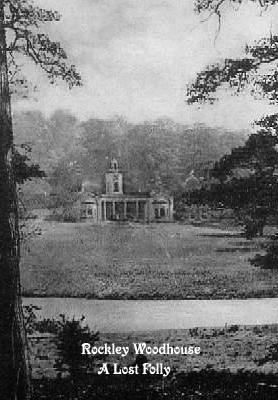15.WENTWORTH CASTLE FOLLIES
Two walks in one! A fabulous sham castle in newly re-emerging gardens, followed by a longer walk around reclaimed parkland with fine views of the rolling South Yorkshire countryside.
Getting There: Wentworth Castle is west of Barnsley, about two miles from junctions 36 and 37 of the M1. Despite its name it is actually about 8 miles away from the village of Wentworth. (See Wentworth Woodhouse walks 09 and 10) Detailed maps and access information may be found on the Wentworth Castle Website.
Distance: Roughly three miles.
Map ref: SE 319 034. LANDRANGER SHEET 110.
Rating: Walk *** Follies and General Interest ***
Website: www.wentworthcastle.org
'When I was a child we used to play and roam here. Then they closed it up for 20 years.'
Such was the comment I encountered from a man exploring these follies with his kids. Now time has come full circle and we live in an age that is finally beginning to realise the historic and cultural importance of our follies and rogue architecture.. Back in the nineties, when I was researching for the Cicerone Guide version of 'Ivory Towers' this was a place I had to pass by, lost in the realms of 'Private Property' 'Dangerous' 'Keep Out'. Now, thanks to appearing on the BBC 2 show 'Restoration' a huge rise of interest and support has brought forward funding from a multiplicity of organisations and restoration of the park and gardens is now underway. Once more the 18th century delights of Wentworth Castle are now open for everyone to enjoy, but there is still much work to do.
For the visitor to Wentworth Castle there are essentially two walks – round the gardens and round the park. The trail around the parkland is free (although it will cost you two pounds to park your car). The admission charge to the gardens however, includes the parking, and as the gardens contain Stainborough Castle, a folly you must see, this is the way to go.
Detailed maps are unnecessary on this walk, as they are issued to you when you visit the site and are far more accurate than anything I could draw, so I will content myself with mere directions.
From the Car Park follow the obvious road to the left that leads round to the Long Barn Information Centre, where you pay to enter the gardens. You are issued with a barrier token (so you can leave the site) and a detailed map sheets of both the gardens and the park trail.
The Long Barn Information Centre contains a gift shop, toilets and a cafeteria which specialises in wholesome food at reasonable prices. It’s a good place to take a snack or a meal after you have explored the gardens and are gearing up to explore the park.
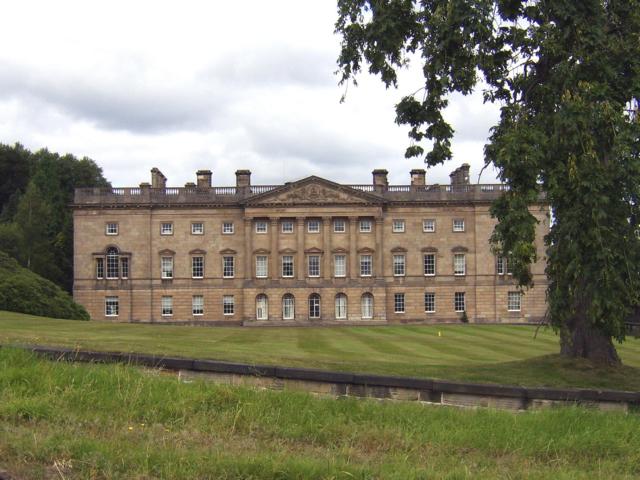
So here we are, In front of the great house, at the start of the Garden Trail. Lets start with a bit of background to the site. Thomas Wentworth (1672-1739) purchased the estate at Stainborough from the Cutler family in 1708, being created 1st Earl of Strafford of the 2nd creation in 1711. Thereafter the house, gardens, parkland and follies were created by Wentworth and his descendants.
But didn't the Wentworths belong to nearby Wentworth Woodhouse you will ask? (See Walks 09 and 10) Well therein lies an interesting tale. Thomas Wentworth actually expected to inherit Wentworth Woodhouse. However, in 1695, at the death of William Wentworth it all went not, as expected , to him, but to his cousin Thomas Watson. He was furious, and it is believed that he built the house in a fit of pique, renaming it Wentworth Castle to spite his neighbour at Wentworth Woodhouse.
Thereafter his rivalry knew no bounds! Whatever his rival built, he set himself to build better, and for us at least, the result is a whole area richly endowed in 18th century follies.
The Wentworths and their descendants lived here until 1948, when the estate finished up in the hands of Barnsley Corporation. The house became a Teacher Training College until 1978 when it finally assumed its present use by Northern College as an adult education facility. The gardens and follies alas, were left to go to seed, eventually becoming derelict and potentially dangerous. Fenced off and ‘keep out’ signs erected-The same old story. But the tide is now turning, and here at Wentworth Castle we can explore anew.
The gardens here are being newly restored and it will no doubt be some years before they reach fruition, but folly restoration has forged ahead. As we follow the trail around the ha ha to the newly restored bridge we reach our first folly
THE CORINTHIAN TEMPLE.
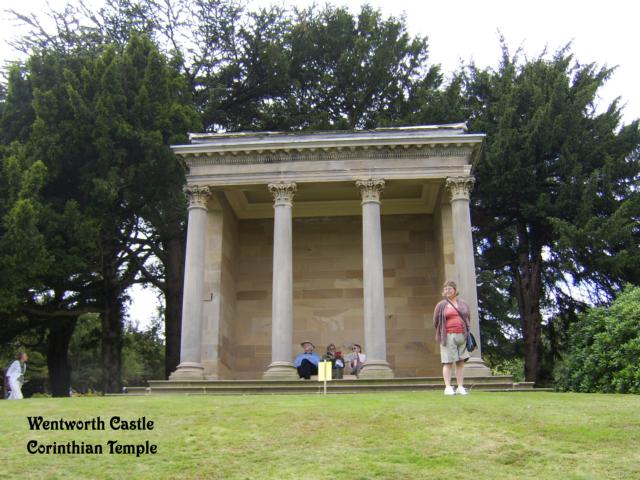
This was built by William Wentworth in the 1760's. The stonework has been cleaned and the internal plasterwork restored. It was a place to sit and enjoy the extensive views across the parkland, views enhanced by William himself, who dotted the distant horizon with a virtual urban landscape of towers, mock fortifications, sham ruins and even a pyramid! Unhappily virtually all of these works have completely disappeared, swallowed up by the urban sprawl of nearby Barnsley! What a folly treasure trove that would have been today!
From the temple we head up the left hand side of the gardens to the
ARCHERS HILL GATE
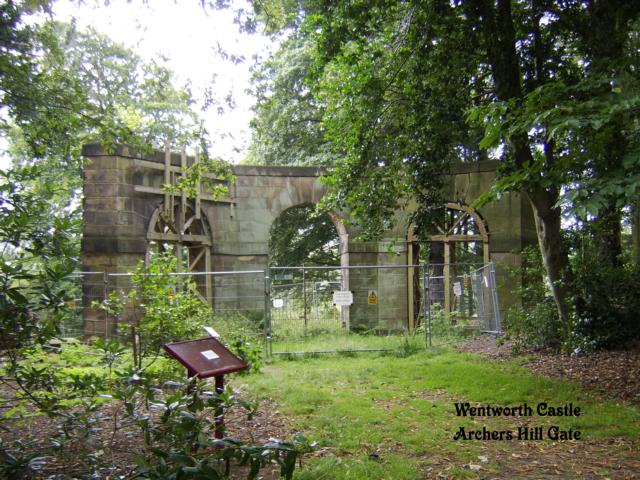
This was built in 1744 by William Wentworth and is in a poor state. Money is urgently required to stop it falling down. The arches were intended to frame vistas across the parkland, and the name probably is derived from Thomas Archer, who designed the baroque front of the house.
Just beyond Archers Hill Gate, where the woodland opens into a fine grassy avenue, a fine obelisk comes into view on the left. This is the
SUN MONUMENT
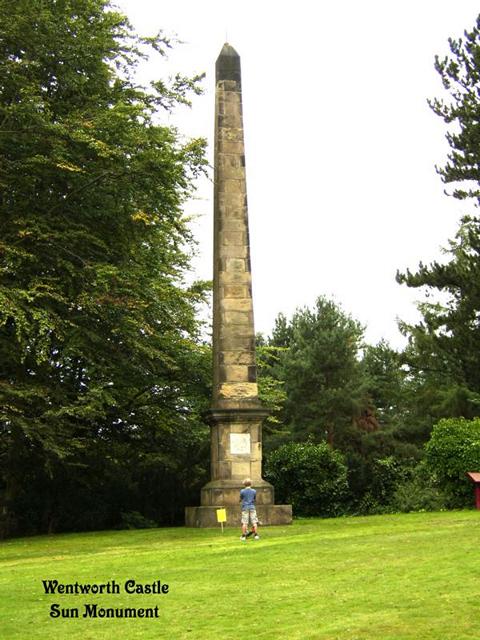
The plaque informs us that the monument was dedicated to Lady Mary Wortley Montagu, who whilst living in Constantinople discovered the secret of vaccination against smallpox. (I was always taught it was Edward Jenner!) But there is an older, marble and largely illegible plaque above it, so it seems the monument originally had some other purpose. Interestingly, there is a large iron spike on top of the needle, and it is said that this originally held a gleaming bronze disc that could be seen for miles around when the solar conditions were right!
In ancient Egypt the obelisk worked as a simulacrum of the sun god Aten-Ra. , whose symbol was the sun disk. The apex of the obelisk represented the centre of the power of the sun and its descending rays. Ancient obelisks were sometimes sheathed in gold and could be used as solar clocks and compasses. The obelisk here is set to one side of the avenue. Surely it would have been more in keeping with symmetry to place it in the centre? But the lore of the obelisk cannot have been unknown to its builder . I have an intriguing theory – discounting the pyramid and possible other structures that were once in the area, there are two further obelisks associated with Wentworth Castle – Queen Anne’s Column at the bottom of the park and the Birdwell Obelisk (see walk 08) on the opposite ridge. Could these monuments be aligned or connected in any way? Herein lies a potentially fascinating line of enquiry.
At the top of the avenue stands the jewel in the crown of Wentworth Castle's follies -
STAINBOROUGH CASTLE.
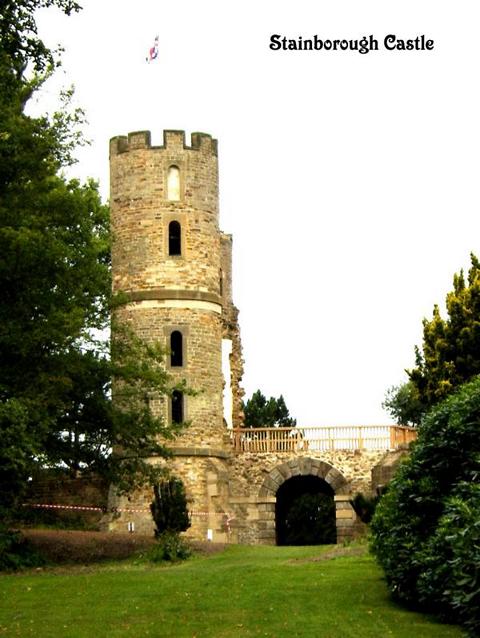
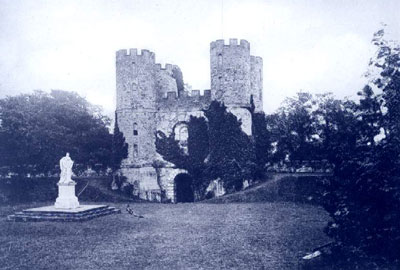
This magnificent sham motte and bailey castle was built in the late 1720's as a garden folly-cum-playground for Thomas Wentworth's children. Each of the four towers around the circular crenellated enclosure was apparently painted inside in a different colour and named after each of the 1st Earl's children, Harriet, Anne, Lucy and William..
The massive gatehouse originally had four towers with a banqueting hall set between them, but much of it fell down in a great storm in the 1960's. The four towers were apparently named after Wentworth and his three daughters. It was built, apparently on the site of an ancient fort, and there may have been at one time some genuine mediaeval work there. It is the highest point on the estate. Prior to restoration it was in a poor condition. The two surviving towers have been saved along with the lower part of the entrance gate. A new steel staircase gives access to the nearest tower, from which there are sweeping views down to Keppels Column and the nearer landmarks of Hoyland Lowe Stand and Worsborough Church (see walk 08).
The castle enclosure was until quite recently completely choked in trees and undergrowth, but now it has been cleared and turned into a lawn with quirky stone seats around it. A great spot for a picnic.Old pictures of the castle show that the centre of this 'bailey' enclosure contained a plinth and a statue, which was presumably the
RYSBRACK STATUE which represents the first Earl in haughty pose wearing Roman armour. It was executed in 1743 and moved to the front of the house for safekeeping.
It has currently been removed for restoration (2007). Will it be returned to its former position in front of the house? or to its original position in the folly. We must wait and see!
From Stainborough Castle we bear left down Lady Lucy's Walk, said to be the haunt of Lady Lucy's ghost! Story goes that she fell in love with a servant, but as was the way in those days was forced to marry against her inclination. It is said her shade now walks the gardens, mourning her forbidden love.
Back behind the house again we reach the next folly on our itinerary
THE GUN ROOM
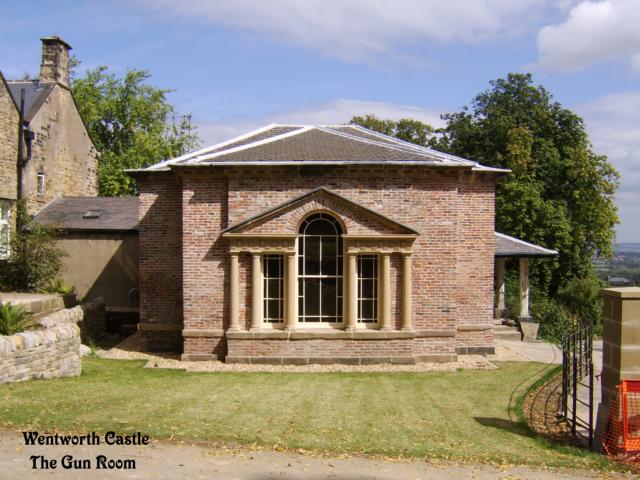
The Gun Room is actually a miniature Palladian Temple, and was probably built as a pavilion or banqueting hall. Its use as a Gun Room dates from the nineteenth century when there was shooting on the estate. It was until recently in a very sad state, and is still only partially restored.
Now we follow the signs back towards the Long Barn Information Centre, but before doing so a detour is in order to see a superb folly not even mentioned in our guidebook. En route back to the barn we cross the main access road for Northern College. (The access road from the bottom of the estate to the visitors car park is a relatively new creation). Turn left along the access road and proceed down to the lodge gate, where there is a bus stop. The PILLARED BARN on our left is of some interest, but our true objective is the gate lodge.
STEEPLE LODGE is built in the style of a miniature church, with a 'church tower' with four pinnacles on it ! It is, of course totally fake! The whole building is in excellent condition, now being a private dwelling.
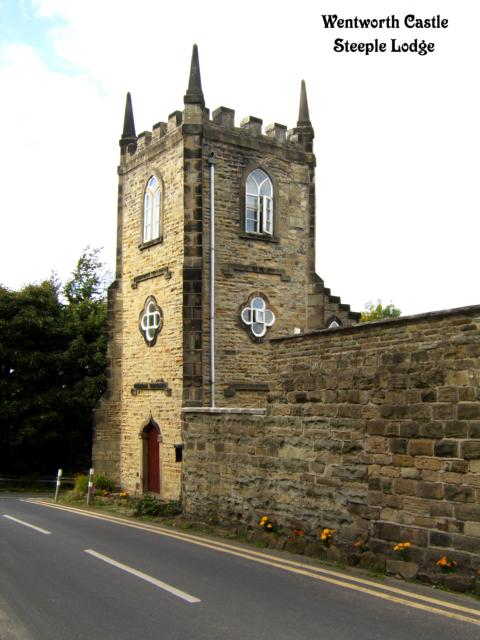
Retrace your steps to the original route , and pass behind the church to the back of the Long Barn Information Centre. Here you may rest awhile if required before embarking on leg two of our perambulation
- the PARK TRAIL.
When the estate passed into council ownership most of the park was sold off as farmland, and so instead of the grand open vision intended by its creators it became a mish mash of hedged arable fields. Now efforts are underway to restore at least some of the park to its former grandeur. There is still a long way to go however.
The PARK TRAIL has only opened to the public this year (2007). There is no admission charge to it, and you can take your dog (under suitable restraint). The route is marked with a succession of posts, and a diagram of the park is on the reverse side of your gardens guide.
From the Information Centre pass through three iron latched gates (the entrance to a planned deer park) and bear left, following a grassy track down the hillside towards a gate by a wood. At the gate, the route leads right along the edge of the wood, but before following it, pass through the gate into woodland to see the remains of the SERPENTINE BRIDGE over a tree and undergrowth choked gully that once was the Serpentine Lake. Beyond the bridge at the far edge of the plantation, a grassy track may be seen leading down to the STRAFFORD GATE, which now stands alongside the new public access road into the park. The grassy track, was of course the line of the eighteenth century entrance.
Return to the PARK TRAIL and bear left along the edge of the wood, within much one may catch occasional glimpses of weed choked ornamental lake. Full restoration is planned, but it will be an onerous and expensive undertaking. Soon the path bears left into woodland (it goes round the wood on the supplied map!) before emerging into a cleared area where THE ROTUNDA comes into view.
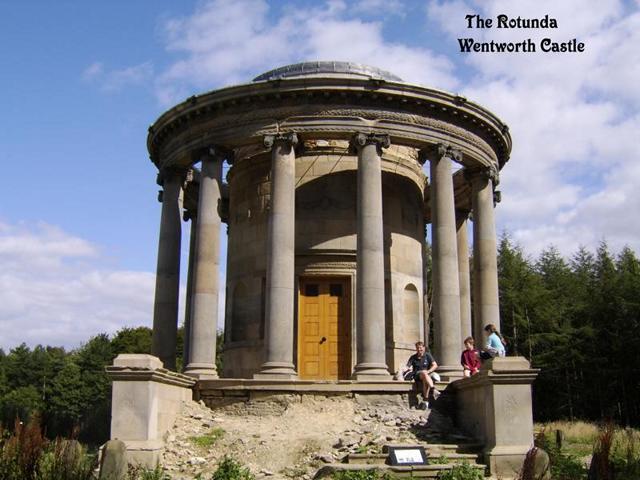
The Rotunda was started in 1739, the year of Thomas Wentworth's death and completed by his son William Wentworth in 1742. A circular ionic temple, Its plan is based on the temple of Hercules at Tivoli, near Rome. Quite recently it was in a very poor state, ruinous and choked with trees. Now it is roofed and partially restored, although the entrance stairs are currently missing. The Rotunda was essentially yet another pleasure pavilion with a basement that may have been used as a wine cellar or as a kitchen for servants to prepare meals for visiting guests. Originally this was a domed building (see photograph).
It is worth remembering that if a folly has any purpose at all it is simply to be seen, to 'catch the eye'. More often than not, (particularly on a country estate) the building is but a featured component part of a greater overall plan, involving parkland, landscaping and ornamental features. The view is everything. Here at Wentworth Castle, where the park is now given over to agriculture and the Worsborough ridge to urbanisation, much of that vision has gone forever. Happily for the rotunda, the encroaching trees here have been felled and old line of sight from the house re-established to restore the follies' original purpose.
Follow the newly laid access track down the hillside, passing a new deer park fence on the left. Just before reaching the wood at the bottom a gothic styled building appears on the right below the wood. In front of it stands the QUEEN ANNE COLUMN.
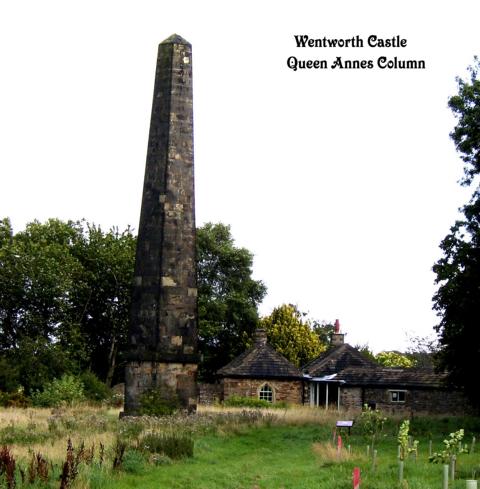
This obelisk was built in 1734 to commemorate Thomas Wentworth's patron Queen Anne. Wentworth lists all of the titles he gained, many of them given to him by Queen Anne. But doesn't mention King George I once, only 'the successor', a man he never served or held office under.
Retrace your route back up the hill to the Rotunda. Beyond it the trail winds left around the woodland boundary, before passing round the edge of arable land to a large gate. Turn left down the hillside to a stile, then right through woodland to the DUKE OF ARGYLL MONUMENT, which, like The Rotunda has been liberated from its choking trees and undergrowth.
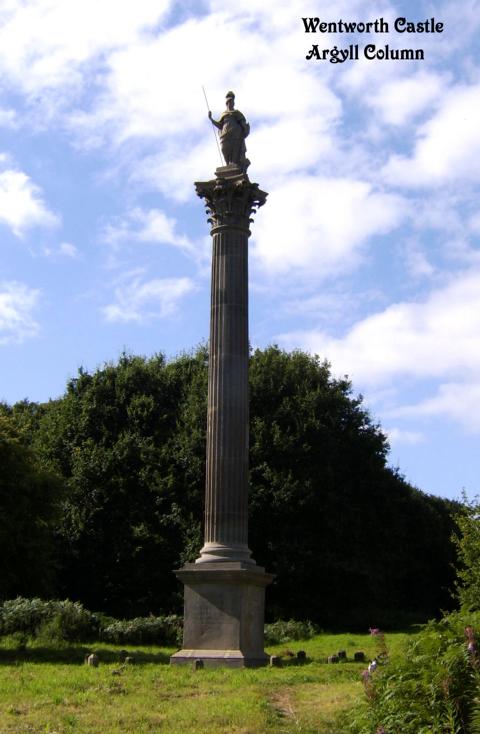
This magnificent Corinthian column was built in 1743 to provide a fine eyecatcher for traffic on the M1. (oops! Sorry!) No, it was built to commemorate John, Duke of Argyll, father in law to William Wentworth and an important agent for the Act of Union with Scotland and surprisingly, in getting King George I to take the British throne. The column is modelled on one in Rome at Santa Maria Maggiore and has a statue of Fame on the top. Or is it? Elsewhere it is described as a column to Minerva! Follies and hearsay go hand in hand!
Return back up the hill to the big gate. Beyond follow the grassy line of the old avenue back to Wentworth Castle and the start of your journey.
Epilogue? While it is marvellous to see our forgotten and neglected heritage coming back to life to be enjoyed by a public it was originally built to exclude, it is also sad to consider how much has been lost irretrievably. Where for example, is the copy of the Chichester Market Cross referred to by Gwyn Headley in the 1980’s. Does it still survive? And if so, does it have a future? Then we have the long gone Chinese Temple, the fortifications, the pyramid known as the 'Smoothing Iron', the 1756 Rockley Woodhouse, a classical building with a tower. If all of these buildings had survived the Barnsley/Rotherham district would be the folly capital of Britain!
In the end Thomas Wentworth and his son outdid their rivals at Wentworth Woodhouse. They had the will, the desire and the means and consequently attained the ends. Posterity, however thought differently, so while most of Wentworths whimsies are gone, those of their rivals, the Rockinghams remain. Such are the treacherous tides of our material aspirations..
